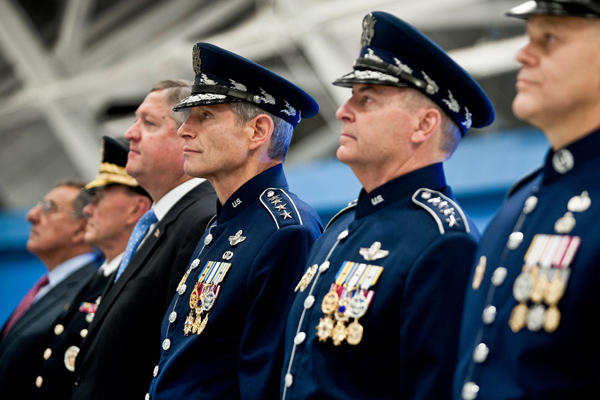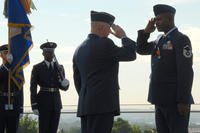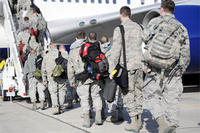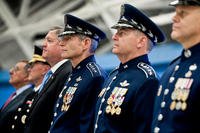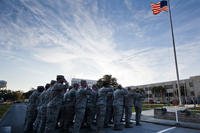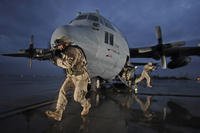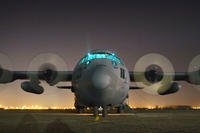Organizational echelons of the Air Force, beginning at the top and proceeding down the chain of command to operating locations, the lowest echelon existing in the Air Force, are defined and discussed below. This review of the types of organizations of the Air Force cannot answer all of the questions likely to arise in the course of an Air Force career. Readers are advised to acquaint themselves with Air Force Instruction (AFI) 38-101, Air Force Organization.
Headquarters US Air Force (HQ USAF)
The senior headquarters of the Air Force, consisting of two major entities: the Secretariat (including the Secretary of the Air Force and the Secretary's principal staff), and the Air Staff, headed by the Chief of Staff, USAF.
Major Command (MAJCOM)
A major subdivision of the USAF, directly subordinate to Headquarters United States Air Force (HQ USAF). They are assigned a major segment of the Air Force mission and possess the full range of staff functions needed to perform required tasks. For brief histories and lineages of past and present USAF major commands, click here.
Direct Reporting Unit (DRU)
A subdivision of the Air Force, directly subordinate to the Chief of Staff. A DRU performs a specialized or restricted mission that does not fit into any of the MAJCOMs. A DRU has many of the same administrative and organizational responsibilities as a MAJCOM. For lineages of the current DRUs, click here.
Field Operating Agency (FOA)
A subdivision of the Air Force, directly subordinate to a HQ USAF functional manager. An FOA performs field activities beyond the scope of any of the major commands. The activities are specialized or associated with an Air Force wide mission. For lineages of the current FOAs, click here.
Separate Operating Agency (SOA)
(Not in current use) Separate operating agencies were major subdivisions of the Air Force directly subordinate to HQ USAF and had all of the "procedural (administrative and logistical) responsibilities" of a major command. In 1991, most active separate operating agencies changed in status to direct reporting units or field operating agencies.
Air Forces
The USAF has used both numbered and named air forces, but only numbered air forces are in current use and active. Although named air forces have been used both tactically and in support roles, numbered air forces are generally found only in a tactical role. During World War II, and for a short period thereafter, the numbered air forces had the status now enjoyed by major commands, with each air force having its own subordinate commands--e.g., Fifth Air Force had the V Fighter Command, V Bomber Command, and support commands. Only very briefly, early in World War II, were air forces identified by an Arabic numeral (e.g., 1st Air Force). Beginning in 1942 the War Department required air forces to be numbered in single series beginning with a spelled-out numeral (e.g., First Air Force).
Today, the numbered air force (NAF) is defined as a level of command directly under a MAJCOM. NAFs are tactical echelons that provide operational leadership and supervision. Many NAFs are responsible for MAJCOM operations in a specific geographic region or theater of operations. For a lineage of the active and inactive numbered air forces, click here.
Divisions *
(Not in current use) Named and numbered air divisions have existed, until recently, since World War II. Many of the numbered air divisions began as wings during World War II, although some of them were postwar organizations. In an effort to encourage rapid decision-making, and to create flat structures without intermediate levels, HQ USAF gradually inactivated or redesignated the air divisions.
*Not to be confused with non-constituted staff elements in HQ USAF, major command, numbered air forces, etc. that supervise activities of branches if the organization is large enough to require branches.
Wings
The US Army Air Service/Air Corps/Army Air Forces wings that existed before 1947 are not comparable with the modern wings of the United States Air Force. In July 1918 the American Expeditionary Forces of the U.S. Army organized in France the 1st Pursuit Wing. Although this wing did not survive post-World War I demobilization, new wings were created in the 1920s and 1930s. World War II wings were very large administrative and operational organizations that usually controlled several combat groups and numerous service organizations, often located at widely scattered locations. Many of the World War II wings were redesignated as air divisions after the war.
Modern wings, as we know them, began their existence with a service test of combat wings in 1947-1948. These wings were initially temporary Table of Distribution (T/D) organizations. In 1948, at the end of the service test, HQ USAF replaced these T/D wings with permanent constituted combat wings each having a combat group, an air base group, a maintenance and supply group, and a medical group.
In most cases, the numerical designation of the wing came from the combat group which preceded it and became an integral part of the post-World War II wing. In other words, when the 14th Fighter Wing (later, 14th Flying Training Wing) came into existence, it received the "14th" numerical designation from the 14th Fighter Group which had already existed for a number of years and which became the wing's combat component. At the same time, the other component establishments, and units of these establishments, also received the "14th" numerical designations, aligning each of them directly to the 14th Wing. The tactical squadrons of the combat group, however, retained their separate and distinct numerical designations.
Today, wings are defined as a level of command below the NAF or higher headquarters. A wing has a distinct mission with significant scope. The USAF has three basic types of wings: operational, air base, and specialized mission. An operational wing has an operations group and related operational mission activity assigned to it. When an operational wing performs the primary mission of the base, it usually maintains and operates the base. In addition, an operational wing is capable of self-support in functional areas like maintenance, supply, and munitions, as needed. When an operational wing is a tenant organization, the host command provides it with varying degrees of base and logistics support. An air base wing usually maintains and operates a base, and often provides functional support to a major command headquarters. A specialized mission wing may be either a host wing or a tenant wing and performs a specialized mission such as intelligence or training.
Groups
A group is a level of command below the wing. AFI 38-101 identifies two types of groups: dependent and independent. A dependent group is a mission, logistics, support, medical, or large functional unit, for example, civil engineers, security police, and so on. An independent group has the same functions and responsibilities as a like-type wing but its scope and size do not warrant wing-level designation. For additional information click here.
Squadrons and Flights
A constituted squadron, the basic unit in the Air Force, may be a mission unit or a functional unit and may vary in size according to responsibility. Organizationally, a constituted flight is treated in the same manner as a squadron. The constituted flight* is the lowest level unit in the Air Force. For additional information click here.
*Elements or parts of squadrons known as Alpha Flights or Functional Flights (such as "Military Personnel Flight") are not units as defined in AFI 38-101 Air Force Organization.
Other Generic Designations
In addition to the organizations already discussed, the Air Force has used in the past, and still employs, a variety of other generic designations to identify organizations. Some of these designations are:
| Academy | College | Institute | Region |
| Agency | Depository | Laboratory | School |
| Area | Depot | Library | Sector |
| Band | Dispensary | Museum | Staff |
| Battlelab | District | Office | System |
| Center | Facility | Organization | Team |
| Central | Hospital | Plant | Unit |
| Clinic | Infirmary | Range | University |
Many of the organizations employing these generic designations are named units or establishments, although in certain categories--such as band, clinic, dispensary, hospital, and infirmary--there have been numerous numbered units. The hierarchical level of such an organization may be stated in the HQ USAF authorization letter creating it or it may be roughly determined by the level of the organization's "parent unit" and/or the level of its subordinate components. Definitions of most of these types of organizations in current use may be found in AFI 38-101, Air Force Organization.
Non-Units
Named Activities
A named activity is one type of functional entity very often mistaken for a unit. Actually, a named activity is a segment or part of a unit, whose mission or purpose can be directly and more adequately identified by the assignment of a definitive name. Examples include the various base NCO Academies and the Academic Instructors' School under Air University.
Alpha or Functional Flights
Constituted flights are units. Frequently mistaken for a unit, however, are unnumbered or alphabetically designated flights such as Flight A of a fighter squadron or the Military Personnel Flight within a wing headquarters. These flights, sometimes known as "alpha" or "functional" flights are not units in their own right. S
Squadron Sections
Squadron sections are sometimes confused with units. For example, a Headquarters Squadron Section, or Patient Squadron Section, although including "squadron" in their designations, are not squadrons; they are merely segments of units and, in the example of a Headquarters Squadron Section, a function responsible for the administrative control of members assigned to the unit. Squadron sections exist because HQ USAF discontinued the generic designation "Headquarters and Headquarters Squadron" in Air Force Letter 20-5, 18 July 1951. At the same time, HQ USAF authorized establishments at group and above to have a "headquarters squadron section" as an integral part of their headquarters.
Detachments
Before and during World War II, many types of constituted organizations used generic designations, such as Detachment, Section, Crew, and Unit, which are no longer used for Air Force controlled organizations. One of these--the detachment--has had its generic name used since World War II in an entirely different manner.
Modern detachments are frequently mistaken for units, but in fact they are merely segments or parts of a unit, generally stationed away from the physical location of the parent unit. Detachments usually carry a number, such as Detachment 5, of a particular squadron. Any unit may have one or more detachments, and some Air Force organizations operate primarily through detachments. Very often, unit honors have been awarded to specific detachments in recognition of outstanding performance or achievement by detachment personnel. A detachment may be analogous to a unit under the Uniform Code of Military Justice when a commissioned officer is appointed by orders as its "commander." Thus, modern detachments are often mistaken for units because they have commanders and are subject to some of the same organizational actions applying to units, including designation, activation, assignment, and inactivation.
But, because modern detachments are not units, they have no lineage, no continuing history, and no authorized official emblem. When a specific detachment is discontinued or inactivated, the detachment (and its history) is terminated even though a similarly designated detachment may later be designated and manned.
Operating Locations
Occasionally, when a very small group of people is separated from the parent unit and the number involved is so small that a detachment seems unnecessary, an operating location (OL) may be designated to account for the people by location. Operating locations do not have commanders, although the highest ranking individual is usually placed in charge.
Air Force Elements
This nomenclature is used to account for manpower authorizations and to identify Air Force personnel on duty with organizations outside the Air Force. Although not a unit for organizational purposes, an element may, in some instances, function as a unit.
